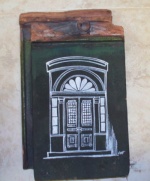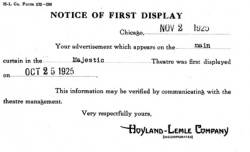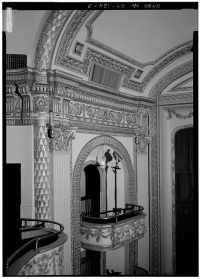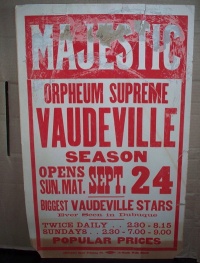Encyclopedia Dubuque
"Encyclopedia Dubuque is the online authority for all things Dubuque, written by the people who know the city best.”
Marshall Cohen—researcher and producer, CNN
Affiliated with the Local History Network of the State Historical Society of Iowa, and the Iowa Museum Association.
MAJESTIC THEATRE: Difference between revisions
No edit summary |
No edit summary |
||
| Line 2: | Line 2: | ||
[[Image:tile.jpg|right|thumb|150px|This tile (8.5" x 14") was kilned in Holland for the roof of the Orpheum Theater. ]]MAJESTIC THEATER. The [[ATHENAEUM]], the earliest theater built on the site at Fourth and Main was constructed in 1840 by Emerson and Childs on the second floor of a building constructed by [[EMERSON, J. Hannibal|J. Hannibal EMERSON]] and [[SHIELDS, John G.|John G. SHIELDS]], the uncle and father of [[SHIELDS, James H.|James H. SHIELDS]] This site in 1877 was called the "Democratic Corner," the record holder for having the longest history of being a theater site west of the [[MISSISSIPPI RIVER]]. | [[Image:tile.jpg|right|thumb|150px|This tile (8.5" x 14") was kilned in Holland for the roof of the Orpheum Theater. ]]MAJESTIC THEATER. The [[ATHENAEUM]], the earliest theater built on the site at Fourth and Main was constructed in 1840 by Emerson and Childs on the second floor of a building constructed by [[EMERSON, J. Hannibal|J. Hannibal EMERSON]] and [[SHIELDS, John G.|John G. SHIELDS]], the uncle and father of [[SHIELDS, James H.|James H. SHIELDS]] This site in 1877 was called the "Democratic Corner," the record holder for having the longest history of being a theater site west of the [[MISSISSIPPI RIVER]]. | ||
C.H. Eighmey and a Mr. Waller purchased, refurbished, and reopened the theater as the Duncan-Waller Opera House in late 1877. The Opera House was a thriving operation until 1893, when it again changed names and became the | C.H. Eighmey and a Mr. Waller purchased, refurbished, and reopened the theater as the Duncan-Waller Opera House in late 1877. The Opera House was a thriving operation until 1893, when it again changed names and became the [[MAIN STREET OPERA HOUSE]]. (4) | ||
In 1896 Charles Bartell leased the building and renamed it [[BARTELL'S DRAMATIC AND VAUDEVILLE THEATRE]]. Bartell's was | In 1896 Charles Bartell leased the building and renamed it [[BARTELL'S DRAMATIC AND VAUDEVILLE THEATRE]]. Bartell's went out of business in 1895. The building remain empty until it was renamed the [[COATES OPERA HOUSE]] by new management in 1904 by Jake Rosenthal, a theater entrepreneur, who assumed control of the theater. (5) | ||
[[Image:imp044.jpg|right|thumb|250px|Photo courtesy: Bob Reding]]In 1909, the [[DUBUQUE OPERA HOUSE COMPANY]] purchased | [[Image:imp044.jpg|right|thumb|250px|Photo courtesy: Bob Reding]]In 1909, the [[DUBUQUE OPERA HOUSE COMPANY]] purchased the theater and renamed it the [[BIJOU THEATER]]. After the first season the theater was closed major renovations. It was reopened as the New Bijou Theater and within a few months was leased to the Western Vaudeville Association of Chicago. A fire destroyed the fifty-three year old structure on April 7, 1910. (6) | ||
After the fire, the site was quickly developed as the first theater designed by the Chicago firm of C. W. Rapp and George Rapp, eventually the leading theater designers in the United States. (7) | After the fire, the site was quickly developed as the first theater designed by the Chicago firm of C. W. Rapp and George Rapp, eventually the leading theater designers in the United States. (7) | ||
[[Image:majth.png|left|thumb|250px|Advertisement.]]The Majestic, built in 1910 at a cost of $90,000 in the style of Renaissance-Flemish architecture, was said to be a replica of | [[Image:majth.png|left|thumb|250px|Advertisement.]]The Majestic, built in 1910 at a cost of $90,000 in the style of Renaissance-Flemish architecture, was said to be a replica of the famous Moulin Rouge in Paris. (8) In 1920, the facility was converted into a movie house. (9) | ||
The building was renamed "The Spensley" in 1929. ( | The building was renamed "The Spensley" in 1929. (10) Its first program was a presentation of the talking motion picture, "Rio Rita." Jack Dempsey, former heavy-weight champion boxer of the world, and his vaudeville act "A Roadside Razz" appeared at the theater in 1930. (11) The stage was turned into a huge cooking school with demonstrations of "ranges, refrigerators, and other culinary equipment" in 1933. (12) | ||
In 1932 even as the U.S. economy foundered, RKO, an American film production and distribution company, began buying up theater after theater to add to its exhibition chain. RKO was formed after the Keith-Albee-Orpheum (KAO) theater chains and Joseph P. Kennedy's Film Booking Offices of America (FBO) studio were brought together under the control of the Radio Corporation of America (RCA) in October 1928. The Dubuque theater, one of many purchased, became part of the RKO film theater circuit and was renamed the RKO Orpheum around 1934. ( | In 1932 even as the U.S. economy foundered, RKO, an American film production and distribution company, began buying up theater after theater to add to its exhibition chain. RKO was formed after the Keith-Albee-Orpheum (KAO) theater chains and Joseph P. Kennedy's Film Booking Offices of America (FBO) studio were brought together under the control of the Radio Corporation of America (RCA) in October 1928. The Dubuque theater, one of many purchased, became part of the RKO film theater circuit and was renamed the RKO Orpheum around 1934. (13) | ||
By 1969 the Orpheum along with much of the area around Lower Main Street was suffering poor economic times. The theater was scheduled for demolition as part of a fifteen-block [[URBAN RENEWAL]] project. Led by such community activists as [[NORMAN, Wayne Andrew Sr.|Wayne Andrew NORMAN, Sr.]], a group developed the idea that private donations could be collected to renovate the theater into part of an exhibition-arts facility. The project was named for the five national flags that have flown over this area. | By 1969 the Orpheum along with much of the area around Lower Main Street was suffering poor economic times. The theater was scheduled for demolition as part of a fifteen-block [[URBAN RENEWAL]] project. Led by such community activists as [[NORMAN, Wayne Andrew Sr.|Wayne Andrew NORMAN, Sr.]], a group developed the idea that private donations could be collected to renovate the theater into part of an exhibition-arts facility. The project was named for the five national flags that have flown over this area. | ||
| Line 101: | Line 101: | ||
Sources: | Sources: | ||
1. "Dubuque County Before 1880," Telegraph Herald, Nov. 2, 1933. Online: http://news.google.com/newspapers?id=BABCAAAAIBAJ&sjid=U6oMAAAAIBAJ&pg=1340,4189885&dq=lumber+yard+fires+dubuque&hl=en | 1. "Dubuque County Before 1880," ''Telegraph Herald'', Nov. 2, 1933. Online: http://news.google.com/newspapers?id=BABCAAAAIBAJ&sjid=U6oMAAAAIBAJ&pg=1340,4189885&dq=lumber+yard+fires+dubuque&hl=en | ||
2. "Theater at Fourth and Main," Online: http://fiveflagscenter.com/AboutUs/History.aspx | 2. "Theater at Fourth and Main," Online: http://fiveflagscenter.com/AboutUs/History.aspx | ||
| Line 115: | Line 115: | ||
7. Ibid. | 7. Ibid. | ||
8. | 8. "An Idea Whose Time Had Come," ''Telegraph Herald'', March 22, 1979, p. 25 | ||
9. " | 9. "Theater at Fourth and Main" | ||
10. " | 10. "Spensley Theatre to Open November 16th," ''Telegraph Herald and Times Journal'', Nov. 10, 1929, p. 22 | ||
11. " | 11. "Dempsey Comes Here Wednesday," ''Telegraph Herald and Times Journal'', April 1, 1930, p. 5 | ||
12. "RKO Pictures," Wikipedia. Online: http://en.wikipedia.org/wiki/RKO_Pictures | 12. "Make Spensley Theatre Ready for Cooking Demonstration," ''Telegraph Herald and Times Journal'', Apr. 11, 1933, p. 5 | ||
13. "RKO Pictures," Wikipedia. Online: http://en.wikipedia.org/wiki/RKO_Pictures | |||
Revision as of 03:21, 20 January 2018
MAJESTIC THEATER. The ATHENAEUM, the earliest theater built on the site at Fourth and Main was constructed in 1840 by Emerson and Childs on the second floor of a building constructed by J. Hannibal EMERSON and John G. SHIELDS, the uncle and father of James H. SHIELDS This site in 1877 was called the "Democratic Corner," the record holder for having the longest history of being a theater site west of the MISSISSIPPI RIVER.
C.H. Eighmey and a Mr. Waller purchased, refurbished, and reopened the theater as the Duncan-Waller Opera House in late 1877. The Opera House was a thriving operation until 1893, when it again changed names and became the MAIN STREET OPERA HOUSE. (4)
In 1896 Charles Bartell leased the building and renamed it BARTELL'S DRAMATIC AND VAUDEVILLE THEATRE. Bartell's went out of business in 1895. The building remain empty until it was renamed the COATES OPERA HOUSE by new management in 1904 by Jake Rosenthal, a theater entrepreneur, who assumed control of the theater. (5)
In 1909, the DUBUQUE OPERA HOUSE COMPANY purchased the theater and renamed it the BIJOU THEATER. After the first season the theater was closed major renovations. It was reopened as the New Bijou Theater and within a few months was leased to the Western Vaudeville Association of Chicago. A fire destroyed the fifty-three year old structure on April 7, 1910. (6)
After the fire, the site was quickly developed as the first theater designed by the Chicago firm of C. W. Rapp and George Rapp, eventually the leading theater designers in the United States. (7)
The Majestic, built in 1910 at a cost of $90,000 in the style of Renaissance-Flemish architecture, was said to be a replica of the famous Moulin Rouge in Paris. (8) In 1920, the facility was converted into a movie house. (9)
The building was renamed "The Spensley" in 1929. (10) Its first program was a presentation of the talking motion picture, "Rio Rita." Jack Dempsey, former heavy-weight champion boxer of the world, and his vaudeville act "A Roadside Razz" appeared at the theater in 1930. (11) The stage was turned into a huge cooking school with demonstrations of "ranges, refrigerators, and other culinary equipment" in 1933. (12)
In 1932 even as the U.S. economy foundered, RKO, an American film production and distribution company, began buying up theater after theater to add to its exhibition chain. RKO was formed after the Keith-Albee-Orpheum (KAO) theater chains and Joseph P. Kennedy's Film Booking Offices of America (FBO) studio were brought together under the control of the Radio Corporation of America (RCA) in October 1928. The Dubuque theater, one of many purchased, became part of the RKO film theater circuit and was renamed the RKO Orpheum around 1934. (13)
By 1969 the Orpheum along with much of the area around Lower Main Street was suffering poor economic times. The theater was scheduled for demolition as part of a fifteen-block URBAN RENEWAL project. Led by such community activists as Wayne Andrew NORMAN, Sr., a group developed the idea that private donations could be collected to renovate the theater into part of an exhibition-arts facility. The project was named for the five national flags that have flown over this area.
In December 1971 the fund drive was launched. In July 1972 architects were hired to design the facility. In November 1972, the ORPHEUM THEATER was placed on the NATIONAL REGISTER OF HISTORIC PLACES. The theater was restored in 1975, renamed the Five Flags Theater and reopened on February 28-29, 1976. With restoration, the main floor seats 322, the balcony 357, and the boxes 38 for a total of 717. The theater has been used annually for performances of the DUBUQUE SYMPHONY ORCHESTRA.
On August 17, 1976, an overwhelming 70% of the voters approved a bond referendum for the construction of the FIVE FLAGS CIVIC CENTER. Besides the arena, which covered 27,000 square feet of floor space and seats up to 4,000, the new plan called for theater support rooms, locker rooms, storage space, and administrative offices. The complex was connected to and designed to complement the restored theater. The new civic center opened its doors in 1979.
---
Sources:
1. "Dubuque County Before 1880," Telegraph Herald, Nov. 2, 1933. Online: http://news.google.com/newspapers?id=BABCAAAAIBAJ&sjid=U6oMAAAAIBAJ&pg=1340,4189885&dq=lumber+yard+fires+dubuque&hl=en
2. "Theater at Fourth and Main," Online: http://fiveflagscenter.com/AboutUs/History.aspx
3. "Dubuque County Before 1880."
4. "Theater at Fourth and Main."
5. Ibid.
6. Ibid.
7. Ibid.
8. "An Idea Whose Time Had Come," Telegraph Herald, March 22, 1979, p. 25
9. "Theater at Fourth and Main"
10. "Spensley Theatre to Open November 16th," Telegraph Herald and Times Journal, Nov. 10, 1929, p. 22
11. "Dempsey Comes Here Wednesday," Telegraph Herald and Times Journal, April 1, 1930, p. 5
12. "Make Spensley Theatre Ready for Cooking Demonstration," Telegraph Herald and Times Journal, Apr. 11, 1933, p. 5
13. "RKO Pictures," Wikipedia. Online: http://en.wikipedia.org/wiki/RKO_Pictures











